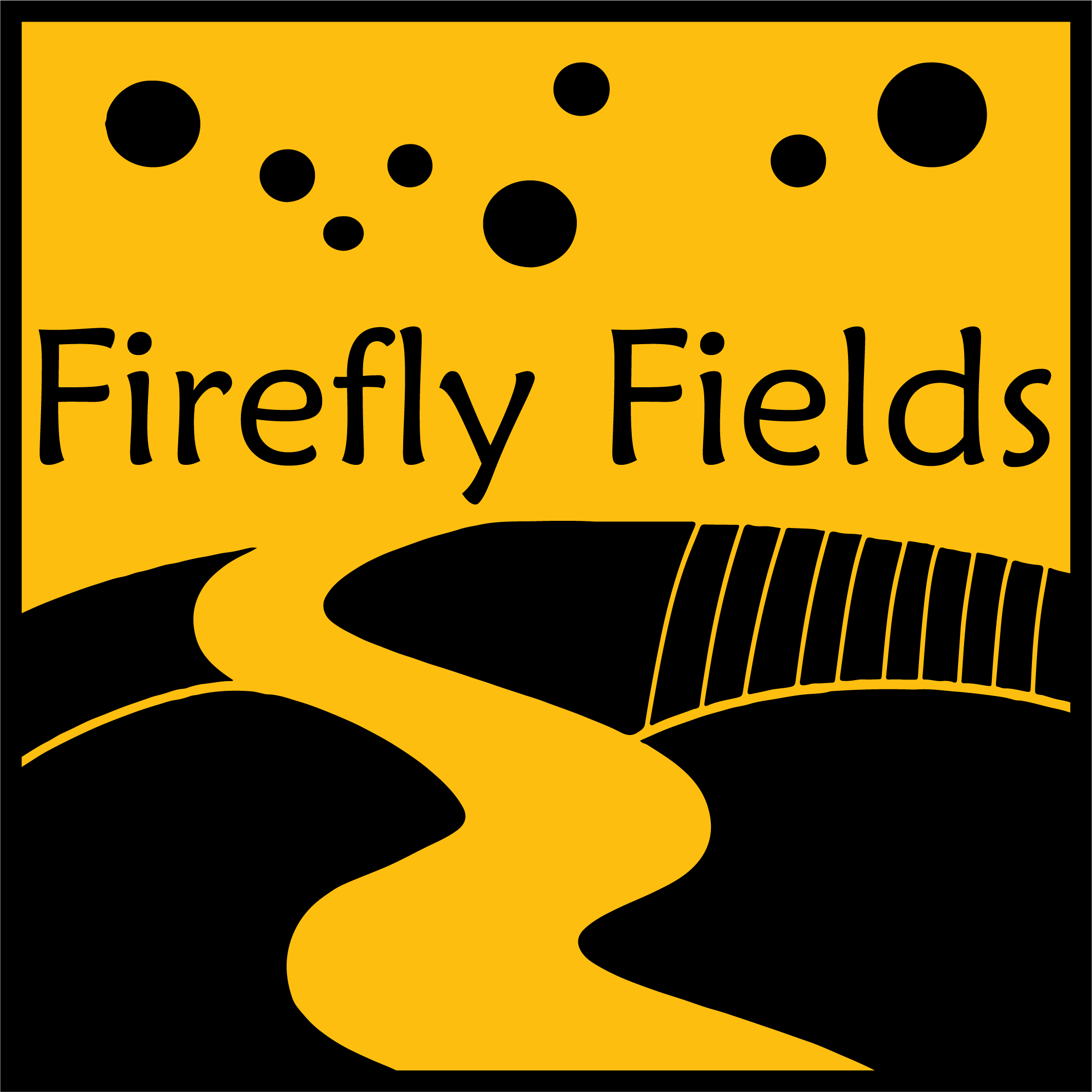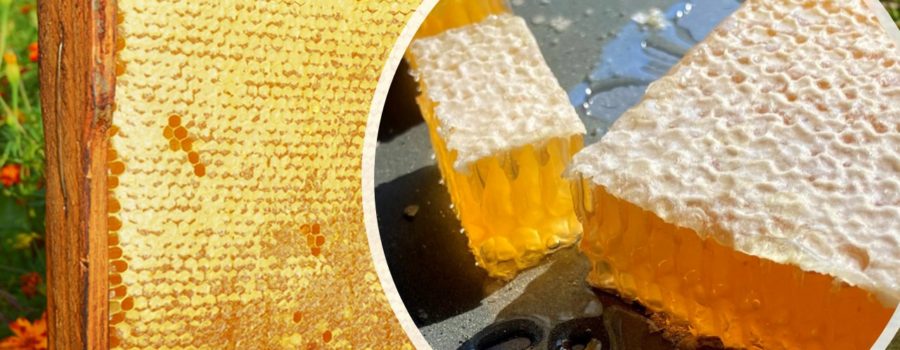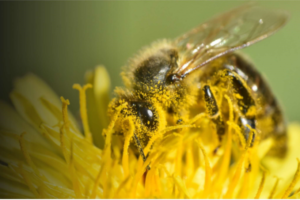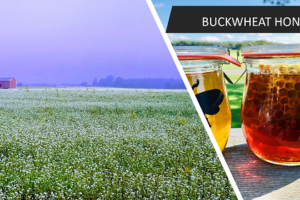Farmer’s Markets on Saturdays are some of the best days for us. In fact, Ben and I usually refer to those days as our ‘date days,’ something in short supply these days as we seem to be in perpetual motion traveling back and forth between our full-time jobs in Indiana and full-time passions on the farm in Michigan. We meet some of the most interesting people from all walks of life. And with those interesting people, all the fabulous stories we exchange especially around shared affections for food.






Comb Honey at the Market
I don’t mean to be over simplistic, but typically we have three types of interactions with potential market customers around the chunk comb honey we sell from the farm’s apiary. We have the…
- ‘Bee-liner’ who moves straight to the honey, ‘Show me the comb honey. I would like honeycomb, please.’ Almost wiggling, waggling, and buzzing themselves like a bee in sheer delight at the mere thought of the honeycomb. Once they catch a glimpse, the comb has no chance. Just as quickly as the bee-liner appeared that comb honey has disappeared…into the loving arms of a very proud owner.
- ‘Honey bee browser’ who takes a slightly more pensive, reflective approach as they slowly approach the table, pick-up the jar, and marvel at the comb for a bit (usually with children nearby). ‘Well…my….look at this. Is this comb honey? Is this where the bees store the honey?’ We then proceed to talk about the honey comb and how bees pack away the flower ‘juice’ into the comb to store it for later. These are always entertaining conversations.
- ‘Honeycomb curious’ who has been noticing the comb honey for weeks and is almost ready to commit, but requires a little more convincing. ‘Tell me about the comb honey. What do you do with it? Can I eat this?…What is up with the comb?’ And for the ‘Honeycomb Curious,’ I have been inspired to write this blog.
A Honeycomb History
The natural, hexagonal honeycomb structure the bees form with their special wax glands has been admired and wondered about since ancient times. The Pantheon in Rome is an early example of architecture that uses the honeycomb structure in the interior ribbing and secret chambers. You can find honeycomb honey referenced throughout Egyptian hieroglyphs, Greek mythology, the Bible, the Quran, and likely other important texts. It’s most often associated with healing properties for humankind.
Pleasant words are as an honeycomb, sweet to the soul, and health to the bones.
Proverbs 16:24, The Bible
From Galileo to Robert Hooke to Charles Darwin, all marveled as they drew reference and comparisons to honeycomb’s seemingly perfect structure and composition. Today, we recognize many important developments the honeycomb technology has inspired from aircraft applications, crash absorption materials, LED technology, furniture, and more. Not to forget, it was often beeswax candles that lit many a Scribe’s papyrus that brought us all these historical records and references.
…the comb of the hive-bee, as far as we can see, is absolutely perfect in economizing labour and wax.
Charles Darwin, On the Origin of Species by Means of Natural Selection, 1859



Can I Eat Honeycomb?
So, while it’s great to look at and have knowledge about all that honeycomb has inspired, can we eat it? YES!
The waxy comb is edible, 100%. You can swallow it. In fact, many of the ‘Bee-liners’ we reference above know this too well. Many of them have had this knowledge passed down to them through generations. It’s amazing to me how many share a common experience of a sweet, nostalgic time spent at their grandparents’ home as children. Grandma and grandpa would crush-up the raw comb honey and spread it on fresh, warm buttered bread or peanut-buttered bread.
Others that delight in comb honey realize that this form of honey is the most pure form of honey and that the comb packs an additional nutritious punch. Honeycomb is a super food that is rich in carbohydrates and antioxidants. It also offers rich vitamins, minerals and protein it gets from the bee pollen, propolis, and royal jelly used to make this structure. Beeswax contains long-chain fatty acids and alcohol, which by some studies suggest it could reduce high blood cholesterol levels. Many view honeycomb with all its potential benefits as a ‘natural medicine.’ Rather than list them all, I reference another blog by Pass the Honey that proposes 10 Benefits of Eating Raw Honeycomb.



How Do I Eat Comb Honey?
Well, of course, eat it however you’d like! I cannot deny it, I eat it straight from the hive. When I’m out in the bee yard and I spot the first spring honeycomb, I use my hive tool to slice a little corner to chew on. If only we all could be this lucky (#grateful); however, we do try to get you the most fresh comb honey possible and here I present some ideas on ways to eat it:
- Eat it straight, dig in with a spoon, and enjoy the chew
- Make it the center piece of your cheese and cracker board, you cannot go wrong with brie, goat, or blue cheese and multi-grain crackers
- Shmear it on your favorite bread or grilled cheese sandwich (we LOVE warm or toasty bread)
- Dip in a cup of warm cocoa
- Add a boost to soups or smoothies, it will dissolve in the soup or get smoothed in the smoothie
- Mix into your baking batter; think scones, pancakes, waffles
- Fold honeycomb into ricotta and serve over pancakes and waffles
- Sweeten your tapioca or other warm porridge with honeycomb
- Slice little chunky bits to toss into your nutty, peppery arugula salad topped with almonds and goat cheese
There are so many ways to enjoy this sweet gift from the ‘hive-bee’ as Charles Darwin called it. You cannot go wrong, and while the list above might give you some ideas on where to start, never forget, it’s always a great bet to keep it simple. Some upscale restaurants will simply present a frame of comb honey (straight from the hive) on the table surrounded by farm fresh cheeses and other delights. Presenting honeycomb in its most pure form is sure to strike up some fantastic conversations and wonder for your table just as it has for thousands of years. Delight!





HEY! We’d love to hear from you! Are you a ‘Bee-liner,’ ‘Honey bee browser,’ or ‘Honeycomb curious? How do you like to eat comb honey? Let us know in the comments. 🙂 Thanks for reading.






Leave a Reply
Your email is safe with us.